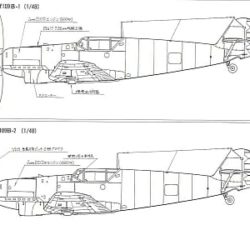Messerschmitt Bf 109B “Bertha” History
Tooling at Augsburg-Haunstetten for the initial production model, the Messerschmitt Bf 109B-1 “Bertha” followed closely behind the batch of ten preproduction B-0 machines, with the first aircraft being delivered in February 1937. They were powered by the improved Jumo 210Da engine with a two-speed supercharger driving wooden Schwarz fixed-pitch prop and offerign 720 hp At 2700 rpm for take-off. A Carl Zeiss Reflexvisier (Revi) C/12C reflector gun sight was provided. Armament was to have been the three MG 17 configuration but trials in Spain with the V4 found that the engine mounted MG 17 firing through the propeller hub was prone to jamming after a few rounds were fired, due to inadequate cooling, consequently the B-1 was delivered without this gun. The oil cooler was removed from the radiator bath and a separate intake was provided beneath the port wing.
JG 132 Richthofen was the first Jagdgeschwader scheduled to receive the Messerschmitt Bf 109B as well as being charged with working up a set of suitable fighter tactics. II Gruppe at Juteborg-Damm was to convert first with I Gruppe at Döberitz converting next. Due to the increased presence of Russian supplied Polikarpov I-15s and the introduction of the even better I-16 Rata, personel of II/JG 132 were put through a hurried conversion course and immediately posted to Spain, with their Bf 109B-1s, arriving o April 1937. Thus, s./J.88 of the Legion Condor became the first operational unit to actually be equipped with the Luftwaffe’s premier new Bf 109-1, relinquishing their Heinkel He 51s to Spanish forces.
In the resultant air combats, the Messerschmitt Bf 109B “Bertha” proved faster than the I-16 (the best fighter operated by the Republicans) at all altitudes; it had a higher operational ceiling, it was faster in the dive and was generally superior above 10,000 ft 93,048 m). For its part, the I-16 could out-turn and out-climb the Bf 109B and was marginally the better fighter below 10,000 ft. In combat the Republican pilots would try to lure their opponents into dogfights below 10,000 ft, but with little success. The Bf 109 pilots quickly learned that superior performance at higher altitude usually gave them the luxury of accepting combat on their terms, or declining it until they had moved into a position of advantage.
During the summer of 1937, after less than thirty examples of B-1 were produced, it was replaced on the assembly line by the Messerschmitt Bf 109B-2, the initial examples of which differed solely in having their fixed-pitch wooden propeller replaced by a variable-pitch, two-bladed prop. Again, the first fighters to roll of the assembly line were rushed to Spain, with a total of 40 Bf 109B-1s and B-2s being eventually shipped to the Legion Condor. The Bf 109 had all but complete mastery of the air over the Iberian peninsula, sweeping its enemies form the skies, and the German propaganda ministry capitalized with the usual exaggerations. History, however, would prove these exaggerations very accurate, only the statement that the fighter was in “widespread” use was a blatantly untrue. In August 1937 only I and II/JG 132 Richthofen and I/JG 234 Schlageter had Bf 109s and none of these were at full strength. It would be November before a fourth Gruppe, II/JG 234 began equipping with the Messerschmitt Bf 109B-2 “Bertha”.










